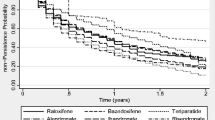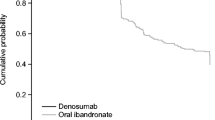Abstract
Patients who are diagnosed with osteoporosis and beginning treatment often discontinue their osteoporosis medication relatively early after the start of treatment because of their poor recognition of fracture risk and the asymptomatic nature of osteoporosis. In this study we aimed to assess adherence to treatment with 1 μg alfacalcidol (D), 60 mg raloxifene (R) or a combination of both (D + R) for 1 year in postmenopausal Japanese women with osteoporosis or osteopenia. We defined persistence of D and R as continuing to take tablets for more than 7 of any 14 days immediately before the 1-year visit. A total of 137 subjects aged 49–81 years [64.9 ± 7.0 years, 16.0 ± 12.7 years since menopause (YSM)] were randomly assigned to each treatment group. The proportions persisting with each treatment group at 1 year were 61.4, 65.3, 55.1% for D, R and D + R groups, respectively whereas the compliance to each therapy as judged by the medical possession ratio (MPR) at 1 year were 77.5, 93.8, 78.4%, respectively. There were no significant differences in persistence, compliance and the number of subjects who discontinued treatment due to adverse events among each group. We found significant inverse correlations in percent changes at 1 year between compliance and serum BAP in R and D + R groups or urinary (u-) CTX in the R group. The changes in the level of serum BAP and u-CTX were significantly higher in high-compliance patients (MPR > 80%) treated with raloxifene alone or concomitantly with alfacalcidol compared to those in low-compliance patients.






Similar content being viewed by others
References
Tosteson ANA, Grove MR, Hammond CS et al (2003) Early discontinuation of treatment for osteoporosis. Am J Inn Med 115:209–216
Eastell R, Garnero P, Vrijens B et al (2003) Influence of patient compliance with residronate therapy on bone turnover marker and bone mineral density response: the IMPACT study. Calcif Tissue Int 72:P297
Yood RA, Emani S, Reed JI et al (2003) Compliance with pharmacologic therapy for osteoporosis. Osteoporosis Int 14:965–968
Caro JJ, Ishak KJ, Huybrechits KF et al (2004) The impact of compliance with osteoporosis therapy on fracture rates in actual practice. Osteoporosis Int 15:1003–1008
Cramer JA, Gold DT, Silverman SL, Lewiecki EM (2007) A systematic review of persistence and compliance with bisphosphonates for osteoporosis. Osteoporosis Int 18:1023–1031
Gorai I, Chaki O, Taguchi Y et al (1999) Early postmenopausal bone loss is prevented by estrogen and partially by 1-alpha-OH-vitamin D3: therapeutic effects of estrogen and/or 1-alpha-OH-vitamin D3. Calcif Tissue Int 65:16–22
O’Donnell S, Moher D, Thomas K et al (2008) Systematic review of the benefits and harms of calcitriol and alfacalcidol for fractures and falls. J Bone Miner Metab 26:531–542
Ringe JD, Farahmand P, Schacht E, Rozehnal A (2007) Superiority of a combined treatment of alendronate and alfacalcidol compared to the combination of alendronate and plain vitamin D or alfacalcidol alone in established postmenopausal or male osteoporosis (AAC-Trial). Rheumatol Int 27:425–434
Lekkerkerker F, Kanis JA, Alsayed N et al (2007) Adherence to treatment of osteoporosis: a need for study. Osteoporosis Int 18:1311–1317
Orimo H, Hayashi Y, Fukunaga M, Sone T, Fujiwara S, Shiraki M, Kushida K, Miyamoto S, Soen S, Nishimura J, Oh-hashi Y, Hosoi T, Gorai I, Tanaka H, Igai T, Kishimoto H (2001) Diagnostic criteria for primary osteoporosis: year 2000 revision. J Bone Miner Metab 19:331–337
Slemenda CW, Longcope CL, Peacock M, Hui SL, Johnston CC (1996) Sex steroids, bone mass, and bone loss. A prospective study of pre-, peri- and postmenopausal women. J Clin Invest 97:14–21
Gorai I, Chaki O, Nakayama M, Minaguchi H (1995) Urinary biochemical markers for bone resorption during the menstrual cycle. Calcif Tissue Int 57:100–104
Blackburn GF, Shah HP, Kenten JH, Leland R, Kamin RA, Kink J, Peterman J, Powell MJ, Shah A, Talley DB, Tyagi SK, Wilkins E, Wu T-G, Massey RJ (1991) Electrochemiluminescence detection for development of immunoassays and DNA probe assays for clinical diagnosis. Clin Chem 37:1534–1539
Garnero P, Borel O, Delmas PD (2001) Evaluation of a fully automated serum assay for C-terminal cross-linking telopeptide of type I collagen in osteoporosis. Clin Chem 47:694–702
Clowes JA, Peel NFA, Eastell R (2004) The impact of monitoring on adherence and persistence with antiresorptive treatment for postmenopausal osteoporosis: a randomized controlled trial. J Clin Endocrinol Metab 89:1117–1123
Osterberg L, Blaschke T (2005) Adherence to medication. N Engl J Med 353:487–497
Siris E, Harris ST, Rosen CJ et al (2006) Adherence to bisphosphonate therapy and fracture rates in osteoporotic women: relationship to vertebral and nonvertebral fractures from 2 US claims databases. Mayo Clin Proc 81:1013–1022
Zanchetta JR, Hakim C, Lombas C (2004) Observational study of compliance and continuance rates of raloxifene in the prevention and treatment of osteoporosis. Curr Ther Res Clin Exp 65:470–480
Rossini M, Bianchi G, Munno ODi et al (2006) Determinants of adherence to osteoporosis treatment in clinical practice. Osteoporosis Int 17:914–921
Caro JJ, Ishak KJ, Huybrechts KF et al (2004) The impact of compliance with osteoporosis therapy on fracture rates in actual practice. Osteoporosis Int 15:1003–1008
Huybrechts KF, Ishak KJ, Caro JJ (2006) Assessment of compliance with osteoporosis treatment and its consequences in a managed care population. Bone 38:922–928
Bouxsein ML, Delmas PD (2008) Considerations for development of surrogate endpoints for antifracture efficacy of new treatments in osteoporosis: a perspective. J Bone Miner Res 23:1155–1167
Reginster J-Y, Collette J, Nerprez A et al (2008) Role of biochemical markers of bone turnover as prognostic indicator of successful osteoporosis therapy. Bone 42:832–836
Author information
Authors and Affiliations
Corresponding author
About this article
Cite this article
Gorai, I., Tanaka, Y., Hattori, S. et al. Assessment of adherence to treatment of postmenopausal osteoporosis with raloxifene and/or alfacalcidol in postmenopausal Japanese women. J Bone Miner Metab 28, 176–184 (2010). https://doi.org/10.1007/s00774-009-0112-4
Received:
Accepted:
Published:
Issue Date:
DOI: https://doi.org/10.1007/s00774-009-0112-4




